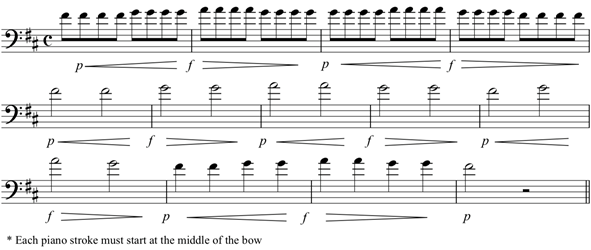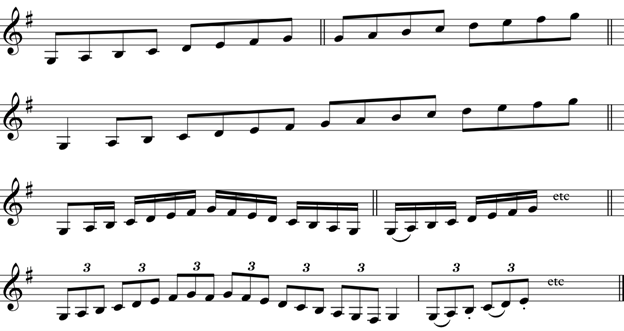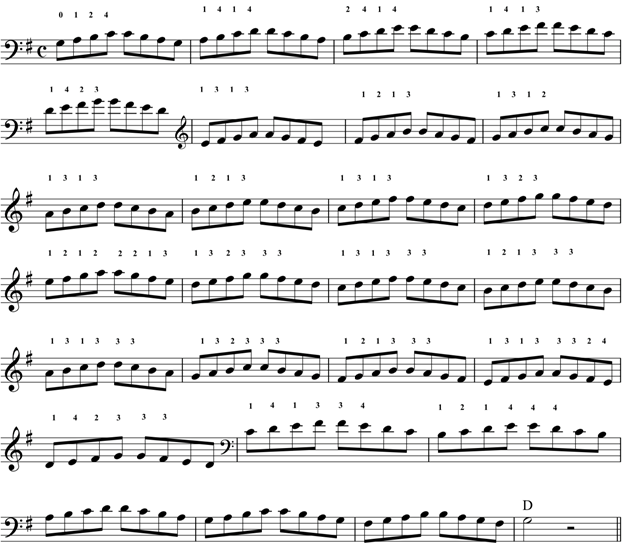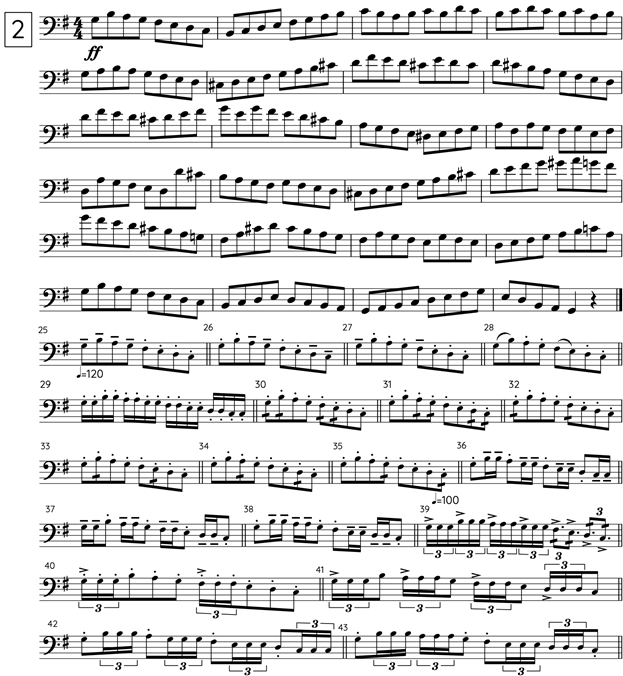Volume 16, October 2022
A Technical Guidance for the Dragonetti Concerto In A Major By Édouard Nanny and Beyond
by Irmak Sabuncu
2. Bow Stroke Types and Their Practice Suggestions in the Piece
Producing the desired sound requires the student to understand that the instrument is sensitive to touch and reacts accordingly. Therefore, being conscious of the standard elements below will be beneficial in obtaining the aimed sonority:3
- Weight: Vertical application of the strength of the right hand to the bow
- Angle: The linear motion of the bow parallel to the bridge
- Speed: The speed of the bow's linear movement
- Placement: Contact point of the bow between the fingerboard and bridge
Furthermore, the vibration frequency of the string determines the pitch, and the vibration amplitude determines the dynamics of the sound produced. This fact needs particular consideration for the strength and speed applied.
Based on these principles, the first exercise (Exercise 1), is derived from the method books of two cello masters from the 20th century: P. Tortellier's How I Play How I Teach4 and M. Eisenberg's Cello Playing of Today5. The exercise should use a full bow at the closest possible spot to the bridge, with maximum string vibration, and change the bow right on the tip and frog. The goal is to raise awareness of the abovementioned principles while suggesting them as a daily practice.
Exercise 1. Irmak Sabuncu, Exercise for Detaché
Slow quarter notes often appear simple, yet they can be problematic in terms of musical expression (Example 1). Besides the sonority requirements, the necessity of crescendo and decrescendo dynamics while applying the bow proportion is a challenge.
The section from the opening of the second movement of the Dragonetti A Major Concerto is demonstrated below:
Example 1. Dragonetti, Concerto in A Major, I, mm. 9-10
Exercise 2 (below) was tailored as a study concerning the challenges.
Exercise 2. Irmak Sabuncu, Exercise for Detaché
Two facts must be considered in this exercise. First, increase the bow proportion to attain the desired crescendo or the opposite for the decrescendo. Second, point the bow tip down on each bow stroke to ensure that it moves closer to the bridge. Crescendo and decrescendo should be considered horizontal movements rather than vertical movements so, using excessive strength should be avoided.
The following section contains alternating groups of the slurred and detached sixteenth and triplet notes.
Example 2. Dragonetti, Concerto in A Major, I, mm. 42–45
The principle is to focus on the minimum number of simultaneous problems and master the skill with the simplest exercise. Thus, Exercise 3 is for preliminarily focusing on the placement, strength, proportion, speed, and angle of the right hand in playing the sixteenth note. It is only performed with note A to ensure bow placement without using the left hand.
Exercise 3. Irmak Sabuncu. Exercise for Sixteenth
The challenge with playing triplets is to divide the beat into three instead of four. It requires a different bow to play each stroke (the first stroke is a downbow, and the second is an upbow or otherwise). This creates a challenge for muscle memory. Exercise 4 will also be a preliminary study for this, and the basic principles mentioned for the right hand.
Exercise 4. Irmak Sabuncu. Exercise for Triplets
The principle of playing the two-slurred, one-separate triplet figure is for playing the third note off the string at the frog. As a pre-workout, at the last measure of Exercise 4, it is recommended to play the A at the first half of the bow, close to the frog by an upbow.
As a continuation, Exercise 5 is designed to improve triplet playing along with left and right-hand coordination. It is derived from the tune called "Max's Magic" from J. Bradetich's technical exercises.6
Exercise 5. Irmak Sabuncu, Exercise for Triplets
Although it is not directly relative to the bow strokes, a principle to consider is that left wrist movements support left-hand finger movements. The left wrist should rotate in the direction of finger movement, resembling a vibrato. In this way, the exercise will also provide ease for left and right-hand coordination. As in Exercise 4, it is recommended to play close to the frog.
Following the coordination study, Exercise 6 can potentially contribute to a fluent G major scale when played with various fingerings.
Exercise 6. Irmak Sabuncu, Exercise for Variations
Exercise 7, inspired by Kreutzer Fiorillo7, can be applied as a final study to offer a systematic development before proceeding to the etude.
Exercise 7. Irmak Sabuncu, Exercise for Variations
The etude number two from Kurt B. Möchel's8 book Zweck-Etüden für Kontrabass will complement the Exercises 1-7.
Figure 3. Kurt B. Möchel, Zweck-Etüden für Kontrabass, 8, 9
|










